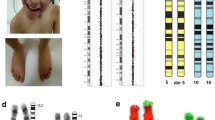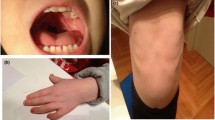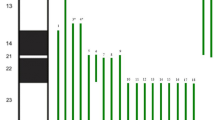Abstract
Unbalanced submicroscopic subtelomeric chromosomal rearrangements represent a significant cause of unexplained moderate to severe mental retardation with and without phenotypic abnormalities. We investigated 254 patients (102 from Zürich, 152 from Liège) for unbalanced subtelomeric rearrangements by using fluorescence in situ hybridisation with probes mapping to 41 subtelomeric regions. Mental retardation combined with a pattern of dysmorphic features, with or without major malformations, and growth retardation and a normal karyotype by conventional G-banding were the criteria of inclusion. Selection criteria were more restrictive for the Zürich series in terms of clinical and cytogenetic pre-investigation. We found 13 unbalanced rearrangements and two further aberrations, which, following the investigation of other family members, had to be considered as variants without influence on the phenotype. The significant aberrations included three de novo deletions (two of 1pter, one of 5pter), three de novo duplications (8pter, 9pter, Xpter), one de novo deletion 13qter-duplication 4qter, and five familial submicroscopic translocations [(1q;18p), (2q;4p), (2p;7q), (3p;22q), (4q;10q), (12p;22q)], most of them with several unbalanced offspring with deletion-duplication. Although the incidence of abnormal results was higher (10/152) in the Liège versus the Zürich series (3/102), similar selection criteria in Zürich as in Liège would have resulted in an incidence of 7/106 and thus similar figures. In our series, submicroscopic unbalanced rearrangements explain the phenotype in 13/254 study probands. The most important seletion criterion seems to be the presence of more than one affected member in a family. An examination of subtelomeric segments should be included in the diagnostic work-up of patients with unexplained mental retardation combined with physical abnormalities, when a careful conventional examination of banded chromosomes has yielded a normal result and a thorough clinical examination does not lead to another classification. The proportion of abnormal findings depends strongly on selection criteria: more stringent selection can eliminate some examinations but necessitates a high workload for experienced clinical geneticists. Once the costs and workload of screening are reduced, less selective approaches might finally be more cost-effective.
Similar content being viewed by others
Author information
Authors and Affiliations
Additional information
Electronic Publication
Rights and permissions
About this article
Cite this article
Riegel, M., Baumer, A., Jamar, M. et al. Submicroscopic terminal deletions and duplications in retarded patients with unclassified malformation syndromes. Hum Genet 109, 286–294 (2001). https://doi.org/10.1007/s004390100585
Received:
Accepted:
Published:
Issue Date:
DOI: https://doi.org/10.1007/s004390100585




